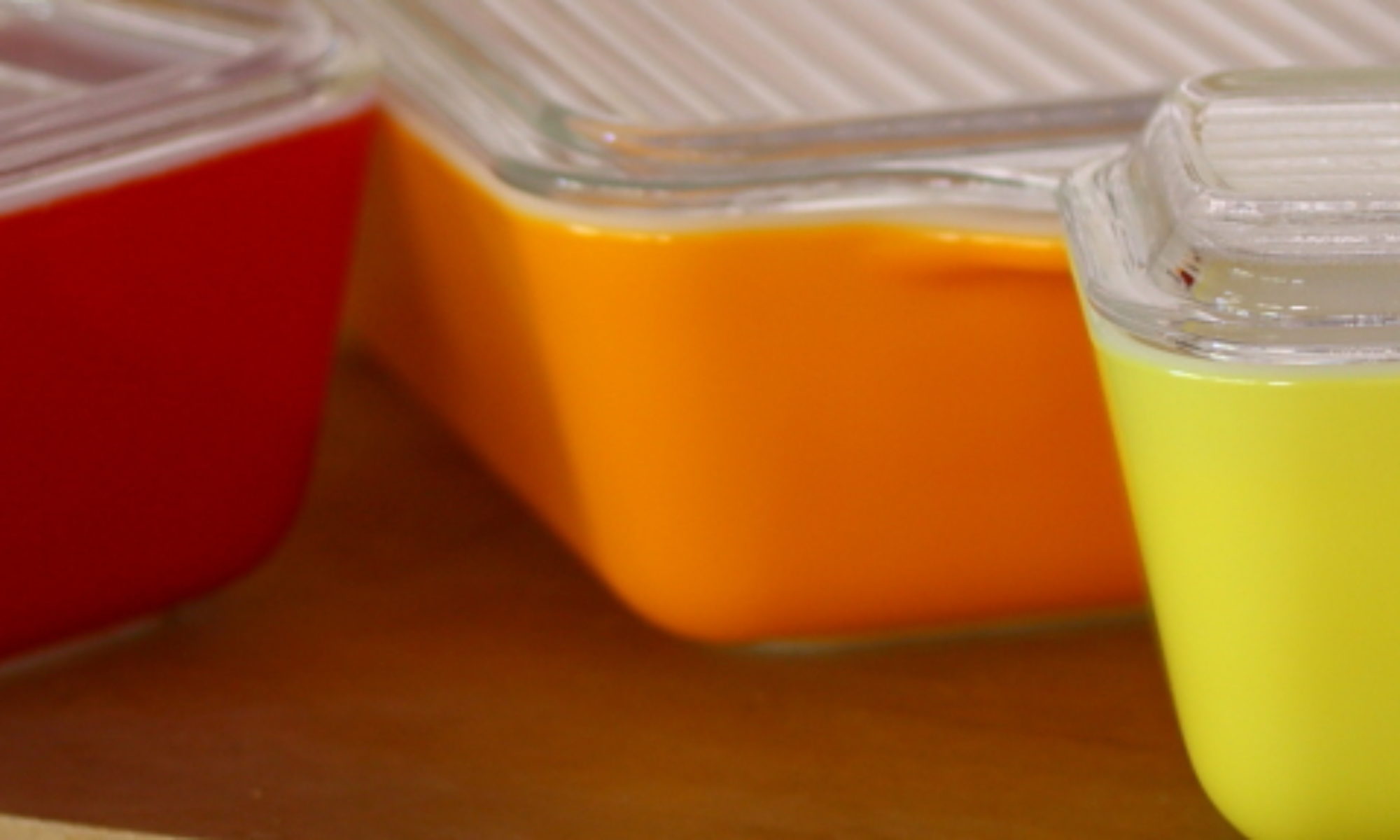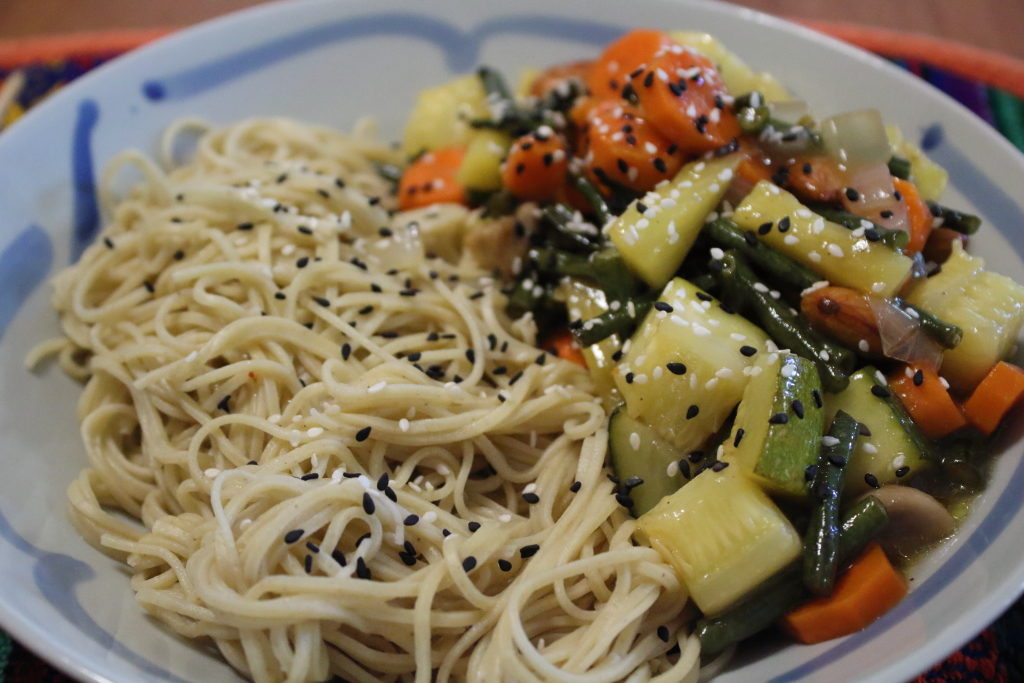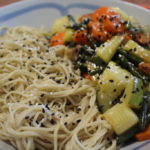
Well, it certainly has been a long time since we put together a new recipe. I guess it’s just a bit difficult to come up with something new and different when you’re staying in most of the time. Plus, it’s a bit more difficult to head out to find special ingredients, even if it is just a trip to the store where we normally shop. Rather than look around, we just try to grab what we need and head for the checkout. So, we rely on a lot of standard dishes that we’ve already written up; therefore, a lack of posts.
Today, we have something for you: Homemade Soba Noodles. Somewhere along the line, we picked up a package of soba noodles on sale at the store. We think they might have been approaching the “best by” date, so they were 50% off. Even so, we think that they were close to $2.00 for a 300g (10 ounce) pack. Sure, they were nicely formed, separated into three 100g bundles and all that, but it’s not as if we’re going to pay the original price of four bucks for less than a pound of noodles. We know how to make noodles, and, how much different can soba noodles be, anyway?
Now, you probably already know that soba noodles are simply buckwheat noodles, so, all we need to do is make up a batch of noodles using buckwheat flour, right? Well, we’re pretty sure that you’ll need some all-purpose flour in there, too, or your noodles just won’t stick together. Besides, we remember looking at the ingredients list of our purchased soba noodles: flour, buckwheat flour, egg whites, salt. We’ll make them with a slightly different set of ingredients, just because that’s what how we normally make almost any sort of noodle, but they’ll still be soba noodles. Ready? Let’s scratch ’em up!
Homemade Soba Noodles
Ingredients
- 60 g buckwheat flour (1/2 cup)
- 90 g all-purpose flour (1/2 cup + 2 Tbs)
- pinch salt
- 10 g extra-virgin olive oil (2 tsp)
- 50 g egg (1 large)
- 30 g water (2 Tbs)
Instructions
- Combine flour, buckwheat flour, and salt in a medium-sized bowl.
- Add olive oil, egg, and water to flour mixture.
- Stir until a shaggy dough forms.
- Turn dough out onto a clean work surface and knead until smooth and uniform, about 5 minutes.
- Wrap in plastic and let rest for 30 minutes.
- Divide dough into four pieces and roll and cut into thin strands like spaghetti, transferring to a towel-covered drying rack as you work. Let noodles dry part way.
- Bring a large kettle of salted water to a boil, add noodles, and boil, stirring and adjusting heat as necessary, until noodles are tender, about 3-5 minutes.
Ingredient discussion:
First, we list the ingredients by weight for a reason: if you use them, you’ll have perfect noodles every time. But, what about the egg? Each has a slightly different weight. So, do as we do, and don’t sweat it; just add 90g of liquid total. That is, place the bowl of flours on your scale, tare it to set it to 0g, and just pour in about 10g of oil, add the egg, then add enough water to make it come up to 90g. Your noodles will now have the perfect consistency, and this trick will work every time. Now, onto ingredients. When we looked for buckwheat flour, it seemed a bit pricey; however, we were able to find whole buckwheat groats that we could grind ourselves. They came in two varieties, a white buckwheat and a darker buckwheat. We choose the lighter version, but now wish we hadn’t, as it lacks flavor. Of course, if you’re not a hard-core scratcher, just go for the buckwheat flour and be done with it. For the egg, we try to use one that came from a happy hen that was allowed to run around and eat grass and bugs. A hen that’s raised better makes better eggs.
And, for credit, this happens to be based on our Basic Pasta Dough recipe, so it’s another 100% Scratchin’ It original direct to you.
Instructions in detail:
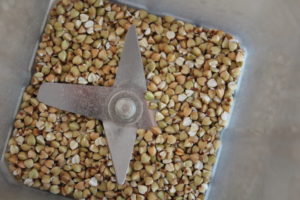
Grind buckwheat. We’re pretty sure that not everyone will do this, but, just in case, we wanted to offer a few tips. First, we use a high-speed blender to grind our grains, which heats the grain and flour. To help mitigate that, we weigh out the amount of buckwheat into the blender pitcher and place it in the freezer for about an hour. Then, when we grind the buckwheat, we do so for 1 minute (we actually count off the seconds). With a shorter length of time, the flour is coarse, too coarse to make nice noodles; longer, and the flour heats up and might scorch. Once ground, into the bowl it goes.

Mix dry ingredients. In a medium bowl, mix together the buckwheat flour, all-purpose flour, and the salt. We add them one by one, then use our finger to stir it all together. We know that we’ll be kneading the dough later, so we might as well get our hands in there now.
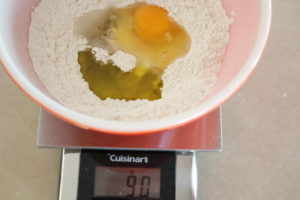
Add liquid ingredients. Since we’re using a scale, it’s really easy for us. We place the bowl on the scale, hit tare to set it to zero, then pour in some olive oil. If it’s a gram or two off, no big deal. Then we add the egg, which is about 50g, but it can vary a bit. Finally, we fill the egg shell with water and add enough to bring the weight of the liquids to 90g. It’s just our way of making pasta and simplifying everything so that we only have a single bowl to clean later.
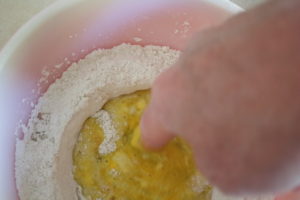
Mix. We do this with our finger, too. We stick our index finger right into the egg to break the yolk and start swirling. Gradually, it’ll bring in the flour, and, as more flour is incorporated, we might start mixing with a couple of fingers and our thumb. Once we have most of the flour incorporated into a shaggy dough, we figure it’s time for kneading.
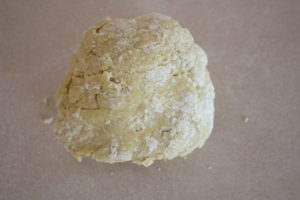
Knead dough. Turn the dough out onto a clean work surface and knead until it’s smooth and uniform. If you measured by weight, the dough won’t stick, and it’ll be easy to knead. If you measured by volume, you might need to add a bit more flour, or a bit more water, to get a smooth, supple, not sticky dough. Once you have a smooth dough, give it another 100 or so kneads and shape into a ball.

Rest. Wrap the dough in plastic and let it rest for at least 30 minutes. Sometime we let it rest as long as an hour, but, much more than that and we’ll refrigerate it, taking it out about 30 minutes before rolling and shaping.
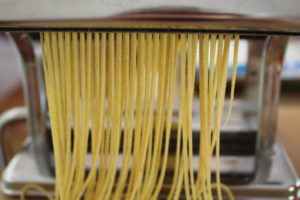
Roll and shape. We have a lot of tutorials for shaping pasta, and the one we use is for spaghetti. It’s really easy with a pasta machine, but you can shape it by hand, too. For us, we divide the dough into four pieces, roll each through the machine until the dough is about 1/16th of an inch thick, then cut it into spaghetti with the appropriate cutter. To help keep the strands from sticking together, we’ll dust the pasta sheets with flour before cutting. As you work, transfer the cut pasta strands to a towel-covered drying rack.
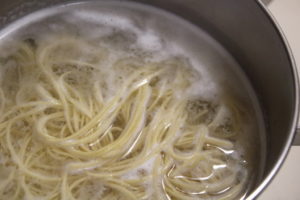
Boil. To cook the pasta, bring a large kettle of salted water to a full boil, add the soba noodles, and boil for about 3 to 5 minutes, or until tender. Drain completely before serving.
We had our soba noodles with a simple sweet and sour stir fry. It’s a nice change of pace to have noodles in place of the standard rice. Since we used the lighter type of buckwheat, our soba noodles weren’t as strongly flavored as the ones we bought at the store. That isn’t to say that they weren’t as good, or were worse, just that they were a milder version, which might be the best choice to go with strongly flavored foods. And now, best of all, we have another type of noodle in our repertoire. Five stars, because it’s a noodle.
